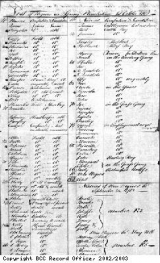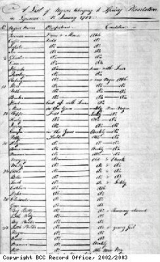Children on the plantations
The slaves on a plantation were expected to work, even the very young and the very old. There were few things that the old and ill might be able to do. An old man or woman might be found work as a watchman at night. The old women might have looked after the toddlers whilst their mothers worked. There were many jobs open to children on a plantation.
This list from the Spring plantation on the Caribbean island of Jamaica is from 1782. It lists the 102 slaves owned by the Smyth family of Ashton Court in Bristol who owned the plantation. Two women, Flora and Venus, are noted as being “Big with Child’. The child of a slave was born a slave, and slave owners usually encouraged their slaves to have children as it increased the number of their slaves at little cost. A man named Harry is ‘Driver for the Children’, that is, in charge of the children’s work. Seven children, Sarah, Phibba, Sue, B. Quasheba, L. Quasheba, Offy and Rose, are listed in the ‘Weeding Gang’. They would weed the growing sugar cane in the fields. Another seven, younger than those in the Weeding Gang, are listed in the ‘Grass Gang’. Their job was to cut grass for the animals and feed them. Eight are listed as ‘No employment as yet very young’. These would be mere toddlers, among the few slaves on a plantation allowed not to be doing productive work. Peter is a ‘Waiting Boy’ working in the house, and Nelly is a ‘House Wench’, presumably a young girl. Phillis is ‘Learning to Wash’ and so was probably a young girl. Kitt and Primus are both given the title ‘Cattle Boy’. They would have taken the herd of cattle out to the fields during the day, kept watch over them and brought them in at night. Hercules and Quashe are both described as a ‘Field Man Boy’.




